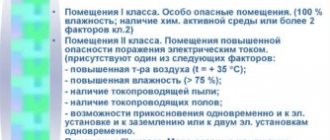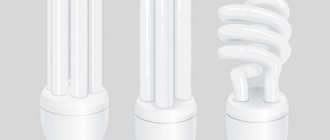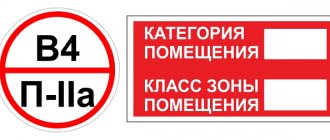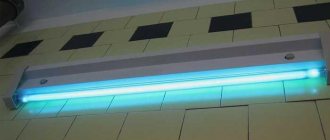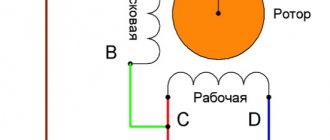With increased danger:
dampness (more than 75%)
conductive dust
conductive floors
heat
the ability to simultaneously touch the metal structures of the building connected to the ground, technological devices on the one hand, and metal casings of electrical equipment on the other.
Particularly dangerous premises:
special dampness
chemically active or organic medium
2 or more high-risk conditions simultaneously
Premises without increased danger - there are no conditions of increased danger
Damp areas - relative humidity above 75%
Particularly damp rooms - relative humidity close to 100%
Hot rooms - the temperature constantly or periodically (more than a day) exceeds 35°C
Dusty premises - due to production conditions, process dust is released.
A room with a chemically active or organic environment - aggressive vapors, gases, liquids are constantly or for a long time contained, deposits and mold are formed.
Ensuring electrical safety, protective grounding, grounding, disconnection. Protective grounding.
Intentional connection to ground of other structural, metal parts of electrical equipment that are not normally energized, but may become energized if accidentally connected to live parts. The purpose of protective grounding is to eliminate the danger of electric shock to a person in the event of touching a body that is energized.
The scope of application of protective grounding is three-phase power supply networks up to 1000 V. with an isolated center.
The operating principle of protective grounding is to remove the voltage between the energized body and to a safe value. So the difference with protective grounding and without current will be approximately 150 times.
Grounding devices
This is a set of grounding conductors - metal conductors. Grounding electrodes can be artificial or natural. Grounding conductors are usually made of sheet steel.
Equipment subject to grounding is metal, non-current-carrying metal parts of electrical equipment, and in rooms with increased danger or especially dangerous grounding installations above 12 volts alternating current or 110 volts direct current.
Zeroing
Zeroing
called connection to the repeatedly grounded neutral wire of the power supply network of housings and other metal parts of electrical equipment that are not normally energized.
The task of grounding is the same as that of protective grounding.
Zeroing principle
— converting a breakdown to the housing into a single-phase short circuit (i.e. a short circuit between a phase and the neutral wire) in order to cause a large current capable of triggering the protection, i.e. disconnect the units from the power supply. Such protection is: fuses, circuit breakers.
Scope of grounding: three-phase four-wire networks up to 1000 V. with solidly grounded neutral.
Protective means
Protective equipment is divided into three groups: insulating, fencing, and safety.
Insulating
— provide insulation of a person from live parts, as well as from the ground. Insulating protective equipment is divided into basic and additional.
Basic insulating agents
- able to withstand operating voltages for a long time (up to 1000 V - rubber gloves, tools with insulated handles).
Additional insulating agents
- up to 1000 v. dielectric galoshes, rugs.
Fencing means
— temporary fencing—boards, portable grounding.
Safety
- safety glasses, gas masks, safety belts.
Grounding and protective electrical safety measures
Terminology
Solidly grounded neutral
- neutral of a transformer or generator, connected directly to the grounding device.
Isolated Neutral
- neutral of a transformer or generator, not connected to a grounding device or connected to it through a high resistance.
Neutral
- common point of star-connected windings (elements) of equipment.
Grounding device
- a set of grounding conductors and grounding conductors.
Ground electrode
- a conductive part or a set of interconnected conductive parts that are in electrical contact with the ground
The following can be used as natural grounding conductors:
metal and reinforced concrete structures of buildings and structures in contact with the ground
metal water pipes laid in the ground
rail tracks of mainline non-electrified railways in the presence of deliberate installation of jumpers between the rails
metal structures or structures located in the ground
metal shells of armored cables laid in the ground.
Artificial ground electrodes can be made of black or galvanized steel or copper. Artificial grounding conductors should not be painted.
Protective grounding
— grounding performed for electrical safety purposes.
Protective grounding
In networks with a solidly grounded neutral, protective grounding is most effective.
Protective grounding
- intentional connection of open conductive parts with a solidly grounded neutral in three-phase current networks or with a solidly grounded source terminal in single-phase current networks, performed for electrical safety purposes.
The principle of operation is the transformation of a short circuit to the housing into a single-phase short circuit in order to cause a large short circuit current, capable of triggering the current protection and thereby quickly automatically disconnecting the damaged installation from the supply network.
Exposed conductive part
- this is a touchable part of an electrical installation that is not normally energized, but which may become energized if the main insulation is damaged.
Direct touch
— contact with live parts
Indirect touch
— contact with exposed conductive parts that become live when the insulation is damaged.
Everything is mixed and intertwined in modern technologies - heat and electricity, gas, and units. But, safety precautions or life safety (Basics of Life Safety) remained unchanged and undoubted. Safety measures are developed after classifying a room or area for danger. This work should be entrusted to specialists who will justify the classification of premises with regulatory requirements and calculation data.
Classification of premises according to fire safety and explosion hazard
| Classification of premises according to the degree of fire hazard and explosion hazard is used in the design of buildings and structures for the subsequent development of fire prevention measures. Fire safety measures depend, first of all, on the fire or explosion hazard of the industries and individual premises located in them. Calculation of the theoretically possible release of fire hazardous substances is a must when designing such buildings and structures. Such a calculation is always made to the maximum, based on specific conditions, and on its basis the premises are assigned one of the hazard categories. Depending on the possible concentration of fire and explosive substances, the same premises with the same production can be assigned to different hazard categories. In general, premises and buildings are divided into five categories according to the degree of fire or explosion hazard. |
| In accordance with ONTP-24 Download (downloads: 355) |
| Hoods from the standard and indicative examples of production facilities located in premises of categories A, B, B1-B4, D and D |
- Category A
The most “evil” category, Category A, is assigned to premises in which flammable liquids or combustible gases with a vapor flash point of up to 28°C are used or used. and below in such quantities that they can form an explosive mixture with air, the explosion of which will create a pressure of more than 5 kPaExamples of category A premises are points and stations for the storage, production, processing, spilling or pumping of flammable gases and flammable liquids (flammable liquids); — premises for washing and processing tanks and containers containing flammable gases and flammable liquids; — warehouses for flammable gases, gasoline and containers for their maintenance; — premises of stationary acid and alkaline battery installations; — hydrogen, acetylene stations; — painting shops and storerooms that use nitro paints, varnishes and solvents made from flammable liquids with a vapor flash point of 28°C and below;
Note Fundamentally, categories A and B are separated only by the ignition (flash) figure of flammable air mixtures (vapors), before and after 28°C. Among the widely used substances that can form mixtures with a vapor flash point of up to 28°C, these are hydrogen, acetylene, natural gas, gasoline and nitro solvent vapors
- Category B
Category B is assigned to premises in which flammable fibers or dust are used or are used, as well as flammable liquids (flammable liquids) with a vapor flash point of more than 28 ° C in such quantities that the mixture they form with air during an explosion can create a pressure of more than 5 kPaExamples of premises of category B are hay flour preparation shops, knockout and grinding departments of mills and grist mills; — workshops for the preparation and transportation of coal dust, wood flour, powdered sugar; — premises for painting work using varnishes and paints with a vapor flash point of 28°C; — warehouses of the specified varnishes and paints, diesel fuel; — pumping and drainage racks for pumping and draining diesel fuel; — areas for the production and repair of parts made of plastics and fiberglass; — departments and areas for washing and wiping components and parts using gasoline and kerosene; — washing and steaming stations for tanks and other containers for fuel oil, diesel fuel and other liquids with a vapor flash point of 28°C; — ammonia refrigeration units; — fuel oil facilities of power plants and boiler houses;
- Category B1-B4
Category B is assigned to premises in which solid flammable substances are processed or stored, including those that emit dust or fibers that are unable to create explosive mixtures with air, as well as flammable liquids that can only burn (not explode). Category B is assigned only if the premises do not belong to category A or BExamples of premises of category B1-B4 - coal racks; — peat warehouses, sawmills, carpentry and feed mills; — shops for primary dry processing of flax and cotton; — feed kitchens, grain cleaning departments of mills; — closed coal warehouses, fuel and lubricants warehouses without gasoline; — electrical switchgear or substations with transformers; — sawmills and woodworking shops; — textile and paper industry workshops; — clothing and textile factories; — warehouses and storerooms for oil varnishes and paints, diesel fuel; — oil warehouses and oil facilities of power plants; — transformer substations; — fuel oil and lubricant facilities of factories; — asphalt and bitumen plants; — car garages; — dressing rooms, archives and libraries;
The same premises with the same production can be included in different hazard categories. The determining factor for such inclusion is the calculation of the maximum permissible concentration of hazardous substances, which is done based on specific conditions
- Category G
Category G is assigned to premises in which fuels, including gas, are burned, or non-combustible substances are processed in a hot, hot or molten stateExamples of premises of category G are boiler rooms, forges, machine rooms of diesel power plants; — foundry, smelting, forging and welding shops; — hot rolling and hot metal stamping shops; — firing shops of brick, cement and lime kilns; — internal combustion engine repair department;
- Category D
Category D is assigned to premises in which non-combustible substances are in a practically cold stateExamples of premises of category D are mechanical workshops for cold metal processing; — blower and compressor stations for air and other non-flammable gases; — pumping irrigation stations; — greenhouses, except those heated by gas; — workshops for processing vegetables, milk, fish, meat;
Classification of premises according to electrical safety
Measures to ensure electrical safety depend on the purpose of the room in which the electrical installation is located and on the nature of the room. Based on their purpose, they distinguish between specialized electrical premises and premises for other purposes (industrial, domestic, office, commercial, etc.). Electrical rooms
- these are such premises or fenced-off parts of the premises in which operating electrical equipment is installed and which are accessible only to personnel who have the necessary qualifications and approval to service electrical installations. Premises with electrical installations are usually characterized by conditions that differ from normal ones, increased temperature, humidity and a large number of metal equipment connected to the ground. All this creates an increased risk of electric shock.
The Rules for the Construction of Electrical Installations (PUE) provide the following classification of premises by microclimate: dry, damp, damp, especially damp, hot, dusty and premises with a chemically active or organic environment
Taking into account these signs, premises are divided into three groups according to the degree of danger of electric shock:
- Premises without increased danger, in which there are no conditions that create increased or special danger
- Premises with increased danger, which are characterized by the presence in them of one of the following conditions that create an increased danger: dampness or conductive dust, conductive floors (metal, earthen, reinforced concrete, brick, etc.), high temperature, the possibility of simultaneous human contact with connection to the ground of metal structures of buildings, technological devices, mechanisms, on the one hand, and to metal housings of electrical equipment, on the other hand.
- Particularly hazardous premises, which are characterized by the presence of one of the following conditions that create a special danger: special dampness, a chemically active or organic environment, or two or more conditions of increased danger at the same time.
- With regard to the danger of electric shock to personnel, the areas where outdoor electrical installations are located are equated to particularly dangerous premises.
Classification of HOME premises according to electrical safety
For home premises there is no such strict gradation of electrical safety as for industrial or public buildings.
However, it will not hurt to remember that:
| Characteristics of HOME premises | ||
| Premises and rooms | Anticipated environment | Electrical Hazard |
| Residential and non-residential rooms, heated and unheated, in dry buildings and premises | Dry, normal | No increased danger In such premises it is allowed to install any certified household electrical appliances and controls for them (switches, sockets, connectors, etc.) |
The analysis shows that the danger of electric shock to a person in electrical installations depends on:
- electrical installation voltage;
- neutral mode of the power supply;
- ground fault current;
- insulation resistance of live parts relative to the ground and grounded structures;
- resistance of the human body;
- soil resistivity in the current spreading zone.
Conventionally, all electrical installations can be divided into:
- electrical installations up to 1 kV;
- electrical installations above 1 kV;
- electrical installations with low voltage (no more than 42 V);
- electrical installations with low ground fault currents ( I
500A); - electrical installations with high ground fault currents ( I z
>500A).
The “Rules for Electrical Installations” (PUE) regarding electrical safety measures divides electrical installations into:
- electrical installations with voltages above 1 kV in networks with a solidly grounded or effectively grounded neutral;
- electrical installations with voltages above 1 kV in networks with an isolated or grounded neutral through an arc suppression reactor or resistor;
- electrical installations up to 1 kV in networks with solidly grounded neutral;
- electrical installations up to 1 kV in networks with insulated neutral.
The first category includes electrical installations in networks of 220 kV and above, working with solidly grounded neutrals of transformers, as well as electrical installations in networks of 110-220 kV, operating with effectively grounded neutrals of transformers (for some transformers in this network, the neutrals are ungrounded, or the neutrals of some transformers are included special active, reactive or nonlinear resistance). Effectively grounded neutrals are used to limit ground fault currents.
The second category includes electrical installations in 3-35 kV networks, operating with an isolated neutral with a relatively small capacitive ground fault current, as well as 3-35 kV electrical installations, operating in the mode of resonant grounding of part of the neutrals of network elements. Grounding of neutrals through arc suppression reactors or resistors is used to limit ground fault currents (to compensate for capacitive ground fault currents).
The operating conditions of electrical installations also significantly affect the risk of injury. Thus, humidity, elevated temperature, caustic vapors, and conductive dust change the insulation resistance of live parts of an electrical installation. Under their influence, human resistance also changes.
Regarding the risk of electric shock to people
the premises differ in:
Premises without increased danger
, in which there are no conditions that create increased and special danger;
Premises with increased danger
, characterized by the presence of one of the following conditions:
- heat;
- the possibility of simultaneous human contact with metal structures of buildings connected to the ground, technological apparatus, mechanisms, etc., on the one hand, and with metal casings of electrical equipment (exposed conductive parts), on the other.
Particularly dangerous premises
, are characterized by the presence of one of the following conditions:
- special dampness;
In terms of the danger of electric shock to people, the territory of open electrical installations is equated to especially dangerous premises.
Tables 3.1 and 3.2 present the classification of premises according to the nature of the environment and the degree of danger of electric shock to people.
Based on the availability of electrical equipment, premises are divided into:
— closed electrical
- locked premises in which electrical equipment is installed that does not require constant supervision. Access to these premises is permitted only to persons from among the electrical technical personnel for a short time (switchgear premises up to and above 1 kV);
Electrical personnel
— administrative-technical, operational, operational-repair, repair personnel who organize and carry out installation, adjustment, maintenance, repair and control of the operating mode of electrical installations (having qualification groups II-V in electrical safety).
— electrical engineering
— premises or fenced-off parts of premises in which electrical equipment is installed that requires permanent electrical personnel (control rooms, turbine room of a hydroelectric power station, etc.);
— production
— premises in which electrical equipment is available for a long time to electrical personnel (workshops);
Electrotechnological personnel -
personnel whose main component in the technological process they control is electrical energy (for example, electric welding, electrolysis, etc.), using hand-held electrical machines, portable power tools (where II or higher electrical safety group is required).
— office and household
- canteens, locker rooms, office premises, living rooms, etc.
Table 3.1. Classification of premises according to the nature of the environment
| Room class | Characteristics of the premises |
| Relative air humidity does not exceed 60% | |
| Relative humidity from 60 to 75% | |
| Relative humidity exceeds 75% | |
| Particularly raw | Relative air humidity is close to 100% (ceiling, walls, floor and objects in the room are covered with moisture) |
| Under the influence of various thermal radiation, the temperature constantly or periodically (more than 1 day) exceeds +35 0 C | |
| Due to production conditions, process dust is released, which can settle on live parts and penetrate into machines, devices, etc. | |
| With chemically active or organic media | Constantly or for a long time contains aggressive vapors, gases, liquids, deposits or mold are formed that destroy the insulation and live parts of electrical equipment. |
Table 3.2. Classification (according to the PUE) of premises according to the degree of danger of electric shock to people
| Room class | Characteristics of the premises |
| No increased danger | There are no conditions that create increased or special danger |
| With increased danger |
|
| Particularly dangerous | The presence of one of the following conditions:
|
Today, every enterprise is equipped with electrical equipment, which significantly increases labor productivity. At the same time, electrical installations can pose a danger to workers if they are in conditions under which the human body’s resistance to electrical voltage is significantly reduced. In this article we will look at what classification of premises exists according to the danger of electric shock according to the PUE.
Appendix B (mandatory) Category of premises and buildings (structures)
Print version Table B.1
| Name of the premises, building, structure | Approximate category of premises, buildings, structures | Fire resistance level of a building or structure | Structural fire hazard class | Characteristics of premises according to environmental conditions and classification of zones according to explosion and fire hazard in accordance with [17] |
| 1 Boiler room | ||||
| 1.1 When operating solid fuel boilers with manual operation. | B1-B3 | II, III | CO, C1 | Normal |
| 1.2 When working on gaseous or explosive liquid fuel, when the volume of the boiler room exceeds the calculated permissible | G | II, III | CO, C1 | Normal |
| 1.3 The same when the volume of the boiler room is less than the calculated permissible, but subject to additional explosion safety measures - (gas fuel) (liquid fuel) | G V1-V3 | II, III | CO, C1 | Normal |
| 1.4 When working on other types of fuel | By calculation | — | — | — |
| 2 Smoke exhaust room | G | II, III | CO, C1 | Normal |
| 3 Deaerator room | D | II, III | CO, C1 | Normal |
| 4 Chemical water treatment rooms | ||||
| 4.1 Filter room | D | II, III | CO, C1 | Wet |
| 4.2 Pre-treatment room with reagent preparation unit | D | II, III | CO, C1 | Wet |
| 4.3 Placement of tanks and pumping stations for reagent solutions with a chemically active environment | D | II, III | CO, C1 | Wet |
| 4.4 Premises of electrodialysis units | D | II, III | CO, C1 | Wet |
| 4.5 Reagent storage premises | ||||
| 4.5.1 Unloading and storing lime, coagulant, salt, soda, acid and alkali in non-flammable packaging | D | II, III | CO, C1 | Normal |
| 4.5.2 Storing phosphates, soda, polyacrylamide in flammable packaging | B1-B4 | II, III | CO, C1 | Fire hazardous zones class II-IIa |
| 4.5.3 Warehouses of sulfonated coal, activated carbon, coke, semi-coke | B1-B4 | II, III | CO, C1 | Fire hazardous zones class II-IIa |
| 5 Control room | B1-B4 | II, III | CO, C1 | Normal |
| 6 Electrical rooms | ||||
| 6.1 Premises of switchgears with voltage up to 1 kV with switches containing 60 kg or less of oil per unit of equipment | B1-B4 | II, III | CO, C1 | Fire hazardous zones class II-IIa |
| 6.2 Premises of switchgears with voltages above 1 kV with switches containing 60 kg or less per piece of equipment | B1-B4 | II, III | CO, C1 | Fire hazardous zones class II-IIa |
| 6.3 Premises of an attached and built-in complete transformer substation (KTP) with oil transformers | B1-B4 | II, III | CO, C1 | Explosive zone class B3/II-I |
| 6.4 Attached and built-in chamber with oil transformer | B1-B4 | II, III | CO, C1 | Normal |
| 6.5 Placement of an attached and built-in condenser unit with a total mass of oil in each, kg: up to 600 inclusive. St. 600 | B1-B4 BI-B4 | II, III II, III | CO, C1 CO, C1 | Explosive zone class B3/II-I |
| 7 Premises and structures for solid fuel supply | ||||
| 7.1 Above the bunker gallery, transfer unit, crushing compartment, closed unloading (receiving) devices, scraper winch room | B or C | II, III | CO, C1 | Fire hazardous zones class II-IIa |
| 7.2 Crushing rooms for milled peat | B | II, III | CO | Explosive zone class B-IIa |
| 7.3 Solid fuel conveyor galleries | B1-B4 | II, III | CO, C1 | Fire hazardous zones class II-IIa |
| 7.4 Rooms for defrosting devices for solid fuel | B1-B4 | II, III | CO, C1 | Fire hazardous zones class II-IIa |
| 7.5 Open (without canopy), free-standing unloading platforms and solid fuel warehouses | — | — | — | Fire hazardous areas class II-II |
| 7.6 Closed coal storage areas | B1-B4 | II | CO | Fire hazardous zones class II-IIa |
| 7.7 Premises of dust preparation plants | B | II, III | CO, C1 | Explosive zones class B-Ia |
| 8 Premises of ash collection devices and structures of “dry” ash and slag removal systems | G | II, III | CO, C1 | Dusty |
| 9 Slag pumping stations, slurry pumping stations and other structures and premises for hydroash and slag removal or “wet” scraper ash and slag removal | D | II, III | CO, C1 | Raw |
| 10 Closed warehouses, valve control chambers, pumping stations and storage tanks for flammable liquids with a flash point above 28°C and flammable liquids, the ignition of which develops a calculated excess explosion pressure in the room (tank) exceeding 5 kPa, as well as flammable liquids heated under production conditions above the flash point | B | II, III | CO, C1 | Explosive areas |
| 11 Closed warehouses, valve control chambers, pumping stations and storage tanks for flammable liquids, if these premises (tanks) do not belong to category B | B1-B4 | II, III | CO, C1 | Fire hazardous areas class II-I |
| 12 External receiving and draining devices for flammable liquids with a flash point above 28°C | BN | II, III | CO, C1 | Explosive zone class B-Ig |
| 13 External receiving and draining devices for flammable liquids | VN | II, III | CO, C1 | Fire hazardous zone class II-III |
| 14 Premises of gas control points (GRP) and flammable gas warehouses | A | II | CO | Explosive zones class B-la |
| 15 Pumping stations | ||||
| 15.1 Pumping stations for drinking water supply and fire-fighting water supply | D | II, III | C1, C2 | Wet |
| 15.2 Condensate pumping station | D | II, III | C1, C2 | Wet |
| 15.3 Sewage water pumping station | D | II, III | C1, C2 | Wet |
| 16 Fur dewatering station | D | II, III | C1, C2 | Wet |
| 17 Repair shop (without foundry, forge and welding) | D | II, III | CO, C1 | Normal |
| 18 Material warehouse | B1-B4 | II, III | CO, C1 | Normal |
Notes 1 The permissible number of floors and floor area of a building (structure) within a fire compartment should be taken according to SP 56.13330 in accordance with the category and degree of fire resistance of the building. 2 In hard-to-reach areas remote from the construction base, boiler houses with a thermal power of up to 3 MW are allowed to be located in buildings of fire resistance class IV, with a capacity of more than 3 MW in buildings of fire resistance class IV with a limitation on floor area in accordance with SP 56.13330 and a building height of up to 18 m. 3 Column 3 shows the approximate category of a typical building (premises) and external installation, which must be confirmed by calculations in accordance with current regulatory documents. 4 The estimated permissible volume of the room is calculated using the formula
| Vadd — | 100 m Ht z |
| 5,58 |
where m is the mass of fuel entering the room, kg Ht is the specific heat of combustion of fuel, MJ/kg; Z is the coefficient of participation of fuel vapors in the explosion. 5 If the free volume of the room is less than the minimum allowable, the room must be equipped with: - a continuously operating automatic gas control system with the installation of sensors for pre-explosive concentrations, emergency ventilation with a rate of at least 5 volumes per hour with a backup fan; — power supply for emergency ventilation according to the first reliability category; — electrical equipment corresponding to the 2nd class zone.
<< back / to contents / forward >>
Main classification
According to the rules for the installation of electrical installations (PUE), section 1.1.13, domestic and industrial, commercial, office premises are divided into classes:
First grade
- premises without increased danger. They are characterized by dryness (humidity does not exceed 45%), the possibility of sufficient ventilation, the presence of a heating system (the temperature should not be lower than 18-20°C) and the absence of dust. In addition, safe rooms must have dielectric floors and a fill factor of the area with metal objects of less than 0.2.
Second class
- premises with increased danger, in which there are factors presenting a danger of electric shock to a person.
In turn, the second class is divided into groups that pose a danger:
- high humidity (up to 100%);
- high air temperature (over 30°C);
- poor ventilation;
- dustiness
- conductive floors, walls.
- conditions under which there is the possibility of simultaneous contact of a person with grounded structures, walls, columns, floors and with the housing of technological mechanisms and electrical equipment.
Third class
- these are particularly dangerous premises (the presence of chemically active substances, high humidity, the presence of two or more conditions that pose a danger).
A group is also identified - the territory of open electrical installations, which is considered particularly dangerous.
The picture below shows how premises are classified according to the risk of electric shock:
The placement and operation of electrical equipment in such rooms is subject to special requirements and protective measures (for example, equipping working personnel with special uniforms, thereby increasing body resistance).
Characteristics of premises according to environmental conditions and fire safety
Introduction
Nowadays, the existence of cities and towns without electricity can only become the plot of some terrible scenario. Electricity literally determines the life of modern man, and even short-term interruptions with it instantly disorient us. For country houses, the problem of power supply is especially acute, because the automation of boilers, pumps, water supply, security systems, communications and much more depend on the availability of energy in the outlet. In this regard, the future developer is obliged to clearly define the list of equipment that will be used in the house in order to correctly calculate the power of the electrical installation - a set of electrical equipment, wires and auxiliary distribution and transmission equipment. This is also necessary so that later you do not have to redo the electrical system and make changes to the project.
The purpose of the course design is to study methods of designing power systems and study the material base. The methodology for preparing working documents is of great importance, which is a good help for the upcoming graduation project.
Characteristics of the design object
characteristics of premises according to environmental conditions and fire safety
) According to the environmental conditions of the tea room and apartment, they include:
Dry rooms
- premises in which the relative air humidity does not exceed 60% are called (most of the premises - sales floor, corridors, director’s office, storage rooms, bedrooms)
Wet areas
- these are rooms in which steam or condensing moisture is released only briefly in small quantities, and the relative air humidity is more than 60%, but does not exceed 75% (toilet, kitchen)
Damp rooms
— rooms in which the relative air humidity exceeds 75% for a long time are called (sanitary unit)
) For explosion and fire hazards:
Category D
- this is a reduced fire hazard because in these rooms there are non-flammable substances and materials in a cold state (all rooms except the kitchen)
Category G —
this is a moderate fire hazard; there are non-flammable substances and materials in a hot, hot or molten state (the kitchen area where the electric stove is located).
Summary table for selection of working machines
The design power of the working machine is determined by the formula [1]:
, (1.1)
where Pmod is the rated power of the electric motor of the working machine, kW;
Aper is the transmission efficiency, which is determined from table [2] depending on the type of transmission used.
The catalog discrepancy coefficient knu is determined by the formula [1]:
. (1.2)
We select the load factor according to table [3], based on the type of electrical receiver.
The overall load factor is determined [1]:
, (1.3)
electrical distribution network pantograph
where kз is the load factor.
The power consumed by the electric drive from the network is calculated using the formula [1]:
; (1.4)
where Pн is the rated power of the engine, kW;
Aper - transmission efficiency
Table 1.1 - Summary table for the selection of working machines
| No. | Name, type of machine | Quantity | Technical data | Broadcast | Estimated power Rcalc, kW | Electric motor | Odds | Power consumed from the network, kW | Working hours | Energy consumption per year, kWh | ||||||||||
| Q, m/h | pH, kW | n, rpm | type | Efficiency | Type | pH, kW | n, rpm | cos | Efficiency, % | Knu | Kz | Kotosh | per day | in year | ||||||
| 1 | Frying cabinet ShZh-150 | 1 | — | 6,3 | — | — | — | — | — | — | — | — | — | — | — | — | 6,3 | 8 | 2920 | 18396 |
| 2 | Electric stove PE-0.34S/SP | 1 | — | 8 | — | — | — | — | — | — | — | — | — | — | — | — | 8 | 8 | 2920 | 23360 |
| 3 | Electric water boiler KVE-30 | 1 | — | 3,1 | — | — | — | — | — | — | — | — | — | — | — | — | 3,1 | 8 | 2920 | 24,8 |
| 4 | Refrigeration cabinet POLAIR ШХ - 0.7 | 2 | — | 0,35 | — | — | — | — | — | — | — | — | — | — | — | — | 0,35 | 24 | 8760 | 1460 |
| 5 | Chest freezer Snezh MLK-250 | 1 | — | 0,18 | — | — | — | — | — | — | — | — | — | — | — | — | 0,18 | 24 | 8760 | 700 |
What is the danger?
As we know, wet objects and water directly contribute to an increase in electrical conductivity, so any room with high humidity can be considered dangerous (especially if moisture constantly accumulates on the floor, ceiling and walls).
High air temperatures lead to aging of insulation and a decrease in the insulating properties of protective coatings, which can also lead to an emergency.
A metal floor poses a danger, such as in conditions of simultaneous contact with electrical equipment and a grounded part of the building.
Chemically active substances can affect the insulation of electrical equipment, as well as contribute to the formation of current-carrying paths from oxides.
It should be noted that to increase safety in production, various measures are used: installation of ventilation systems, laying of dielectric flooring. All this allows us to minimize personnel injuries that occur when working with electrical equipment!
In accordance with the PUE, according to the degree of danger of electric shock to people, production premises are divided into:
- Premises with increased danger.
- conductive dust;
conductive floors (metal, earthen, etc.);
high temperature (more than 35ºС);
relative humidity more than 75%;
the possibility of simultaneous human contact with the metal structures of buildings, technological equipment connected to the ground, on the one hand, and with the metal casings of electrical equipment, on the other hand.
The premises are especially dangerous.
They are characterized by the presence of one of the following conditions:
- special dampness (humidity about 100%);
chemically active or organic medium acting on insulation;
simultaneous presence of 2 or more conditions for high-risk premises.
Premises without increased danger.
They do not contain conditions that create increased or special danger.
